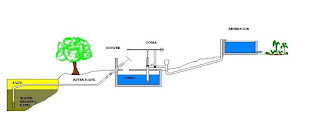Water storage in sand rivers has several advantages, such as;
1) Evaporation losses are reduced gradually to zero when the water level is 60-100cm or below the sand surface.
2) Livestock and other animals cannot contaminate the water reservoir because it is hidden under a surface of dry sand.
3) Mosquitoes, and insects that carry water-borne diseases, cannot breed in underground water reservoirs.
Water is naturally retained in the sediment of sand river channels although in a dry riverbed this is not always apparent. The water in a sand river is clean and not subject to the same amount of evaporation as an open surface dam. Sand river water supplies can be used to augment the supply of water from underground aquifers and dams, especially in remote rural areas where it is imperative that local communities are able to operate independently and maintain their own water supplies. Sand dams and subsurface dams function like sand rivers as they retain water in the sediment and reduce evaporation.
The Dabane Trust has installed simple handpump technology sand-abstraction systems at some 100 sites in Zimbabwe over a period of 14 years. The original installations put in place in 1992 are still in operation, independently managed by rural community groups.
The picture below shows the layout of a typical small-scale sand abstraction system as developed by Dabane Trust with a single home-made well-point and a flexible connecting pipe to a rower pump on the riverbank. The rower pump is situated no more than 5 metres above the saturated river sediment level and discharges water into a sump. Water is then transferred a greater distance and height by a Joma pump to a water supply point such as a water storage tank in a garden. This can be several hundred metres distant and some 8 metres higher. The Joma pump uses rower pump components in uPVC pipe work with standard pipe fittings mounted in a steel frame.
2) Livestock and other animals cannot contaminate the water reservoir because it is hidden under a surface of dry sand.
3) Mosquitoes, and insects that carry water-borne diseases, cannot breed in underground water reservoirs.
Water is naturally retained in the sediment of sand river channels although in a dry riverbed this is not always apparent. The water in a sand river is clean and not subject to the same amount of evaporation as an open surface dam. Sand river water supplies can be used to augment the supply of water from underground aquifers and dams, especially in remote rural areas where it is imperative that local communities are able to operate independently and maintain their own water supplies. Sand dams and subsurface dams function like sand rivers as they retain water in the sediment and reduce evaporation.
The Dabane Trust has installed simple handpump technology sand-abstraction systems at some 100 sites in Zimbabwe over a period of 14 years. The original installations put in place in 1992 are still in operation, independently managed by rural community groups.
The picture below shows the layout of a typical small-scale sand abstraction system as developed by Dabane Trust with a single home-made well-point and a flexible connecting pipe to a rower pump on the riverbank. The rower pump is situated no more than 5 metres above the saturated river sediment level and discharges water into a sump. Water is then transferred a greater distance and height by a Joma pump to a water supply point such as a water storage tank in a garden. This can be several hundred metres distant and some 8 metres higher. The Joma pump uses rower pump components in uPVC pipe work with standard pipe fittings mounted in a steel frame.

